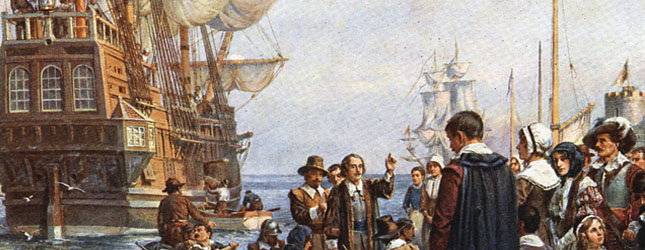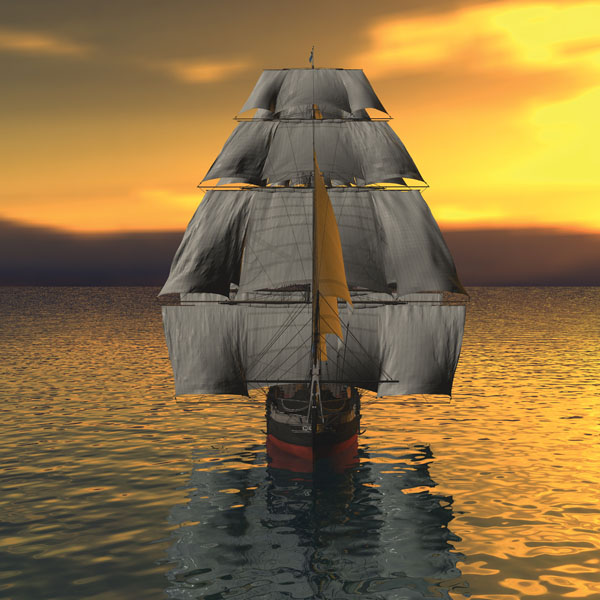A thousand tales have been spun about the Mayflower immigrants who ventured to our shores in 1620, but there is more to the colonization story. My curiosity was ignited when colleague, Joe Silva, and I were volunteer appraisers at the Danville Railroad Museum. As appraisers and avid history buffs, we chatted about Pilgrim stories, as my recent DNA results hinted that a distant relative may be a Mayflower descendent, and I boasted the possibility of having a feather in my heretofore, unknown colonial cap.
Joe Silva added that over 20 million Americans can lay claim as Mayflower descendants, thus deflating the importance of my belonging to this historic gene pool. He revealed that he is English-Scottish-Mexican, and direct descendent of John Billington, the first man to be hanged in New England for murder. Well I knew there were more salacious stories than just turkey dinners and Pilgrims, so I researched the subject. I discovered many kernels of scandal about Virginia plantation speculators, and the God-fearing Pilgrims, that went far beyond the history books.
The biggest shock was the indentured child labor practices in the Colonies, and how little boys and girls were rounded up for transportation. It was common knowledge that pressers “shanghaied” sailors for service on the high seas, but corralling very young street children to work in the Colonies surprised me.
One such incident darkens the Mayflower’s auspicious history. In 1620, four small children, under the age of eight, were brought to New England shores as indentured servants to work as planters in Virginia. Ellen More was only eight; Jasper was seven, Richard, six, and Mary was four years old. The siblings were listed as servants. Three of the More children died during the bitter cold, one winter onboard the Mayflower anchored in the harbor, and six-year old Richard More was the only survivor of the four siblings.
Richard More lived to tell the story. He was thrice married, had children, and became a sea captain. He died at 84 in Salem, as marked on the original gravestone. He is regarded as the only Mayflower passenger to have had royal blood; related to William the Conqueror, Henry I, and Edward I, II and III.
The story of how these four children came to be on the Mayflower is heartbreaking. Their father purposely disposed of the children by banishing them to work the fields of Virginia. London was a microcosm of Britain’s social ills, decrepit laws, and those left in the wake of the pursuit of 17th century expansionism. The gentrified landowners paid laborers a pittance, and the death and neglect of unwanted children was rampant. Beggar waifs blighted the streets, and to rid cities of crime, authorities rounded up little children and condemned them to labor in the colonies.
But the four More children aboard the Mayflower were not poor street waifs, as their families were wealthy landowners. Samuel More inherited title to the Larden estate by marrying his first cousin, Katherine More, seven years his senior. It was not until 1959 that documents discovered in an attic, revealed what really happened three centuries earlier, in 1620.
Samuel More, of Shropshire, was lord of the vast estate through the arranged marriage, as women could not inherit property. The Mores leased a portion of the property to the Blaskeway clan.
When Samuel More discovered that wife, Katherine, had committed adultery with tenant Jacob Blaskeway, he denied the four children were his kin, disowning them by claiming a strong likeness to the putative father, Jacob. Katherine admitted her illegal liaison, and confirmed they were Jacob’s children.
Enraged, Samuel approached Lord Zouche, head of Privy Council, and an investor in the Virginia Company in America. They devised a plan for the disposal of the four ‘bastard’ children in retaliation against his wife’s betrayal. Samuel More also cut the children from all inheritance, and denied their very existence. He removed them from Larden Manor in April 1616, just after baby Mary’s baptism, and sequestered them for four years in a tenant dwelling on his land.
After years of litigation, Katherine found her children; “In a hail of murderous oaths, she did teare the cloathes from their backes…” Samuel refused to return the children to their mother and delivered them to John Carver in London in July 1620. Carver was ordered to transport the ‘servant children’ along River Thames to Southampton, and then to open seas to work on the Virginia plantations.
The chartered Mayflower carried 65 passengers from London, including plantation speculators, and 37 self-governing Puritans from Leiden, Holland. There were 102 passengers, plus a crew of 35. By the time the 180-ton ship was under full sail on September 6, 1620, passengers had already been onboard the fluyt for nearly a month. Beloved England was behind them forever.
The More children were put in the care of four families as indentured servants aboard the vessel. Captain Christopher Jones and Surgeon John Parker sailed rough seas on the 66-day voyage. The ship’s manifest showed that Peter Brown brought a mastiff, John Goodman a spaniel, and others brought cats, dogs and birds. Supplies were casks of rum, beer and wine, sheep, goats and chickens along with cannons, weapons, gunpowder, and a 21-foot dinghy.
During mid-journey a fierce storm broke rafter boards flooding the belowdecks sleeping berths. Passengers were wet and cold, many becoming ill. Two died on the voyage, including a newborn. Elizabeth Hopkins gave birth to a boy named Oceanus, and Susanna White (later Windsor) had a son named Peregrine, born ashore and not considered a Mayflower passenger.
Passengers’ Christian names tell of their faith, adding to their religious mindset; Love, Fear, Wrestling, Remember, Humility, Desire, Story, Truelove and Resolved.
Historical dates may confuse; Julian AND Gregorian calendars are depicted in history books, as common usage of both were used in mid-17th century. The first Mayflower land sighting shows 9/19 November, a ten-day span, and November 11/21 as Mayflower Compact signing (document to establish legal agreement between signatories spearheaded by William Bradford.) This writer refers only to Gregorian dates; thus the first sighting of Cape Cod Hook headlands was 19th November 1620, now Provincetown.
NEW WORLD PILGRIMS
The Newcomers reconnoitered the snowy shoreline to build a safe settlement. They found serendipitous mounds of corn and beans buried for winter by the local Nausets. While the hardy men sought safe locations, women and children remained aboard in the airless dark bowels of the ship floating in the windy bay. Contagious sickness was rampant. Many were ill with scurvy, pneumonia and tuberculosis. Half of the passengers were dead before the year’s end. Of the 102 passengers, only 53 survived.
Mary Allerton, three years old when she disembarked the Mayflower, was to be the last survivor of all the passengers who sailed on the fateful voyage to America.
They finally disembarked the Mayflower in spring 1621.Those with enough strength dragged six weighty cannons uphill, some as long as eight feet and powerful enough to propel three-inch cannonballs, 1700 yards. The colonists drank beer and rum, played cards by candlelight, and cooked in sand-filled fireboxes. A one, William Morris, sold haberdashery; shoes, boots, oiled leather and canvas, breeches, jerkins, doublets, neck-cloths, caps, hose and belts. Others named Carver, Winslow, Brewster, Fuller, Mullins, Tilley, Turner, Soule, Cooke, and Gardiner went about fishing, hunting and planting.
The Puritans built a church, befriended Indians, and enjoyed a winter feast of roasted vulture birds and corn under the oaks. And Captain Myles Standish, who maintained order with his broadsword, was challenged by the Billington clan of troublemakers. Incorrigible John Billington was hanged in September 1630 for the murder of John Newcomen in Plymouth, and whose wife, Elinor, was whipped in the stocks for slander. She promptly married Gregory Armstrong, after her husband’s hanging. Their obstreperous sons, John and Francis Billington, revolted against all authority, and may have been the nation’s first teenage delinquents. Francis married Christian Eaton in 1634 and they had nine children.
The once-mighty Mayflower, one of the most storied sailing ships of the New World, limped back to England. On May 4, 1624 an appraisal was done of her worth for the three surviving owners to settle Captain Christopher Jones’s estate. Then dismantlers removed guns and cannons and the dowager sailing ship was broken up in a wrecker’s yard. Lumber from her oak hull was cut up and used to build a horse barn in Jordon’s Village, Buckinghamshire.
One can only imagine the twisted history stories that were locked in the heart-of-oak hull, the dank berth sidings, the creaking acrid galley, the worn gunwales, the stern and stem, hundreds of yards of canvas sailcloth, and the high forecastle, where Captain Jones sighted Cape Cod and Plymouth, before dropping the iron anchor. It is not hard to envision the carcass of the ship’s 100-foot hulk that forever holds the history and mystery of those who perished belowdecks, and the little More children who were never to see their mother again, and never to set foot on the New World shores except wrapped in cloth for burial. We can imagine what great things those who perished may have achieved for our great land, and who too, may have lived to be our ancestors.
DESCENDENTS
In order to join one of the prestigious Mayflower Societies, such as Society of Mayflower Descendants in California, a purported descendent must provide impeccable documentation to lay claim to historical First Comers. Documents must be proof of relationship, birth, marriage and death records, letters and other watertight evidence, such as DNA. Each Mayflower passenger is accounted for; as are marriages, and five generations of confirmed descendants.
If historians calculate there are over 20 million Mayflower descendants, there’s a lot of generational evidence to sift through and gather. My rough estimation is there may be 13 to 14 generations in the 393 years since arrival at Plymouth Rock. So, one may have to hopscotch on conceptual chains of many generations, to establish a Mayflower pedigree. Those who afforded the best genealogists on earth have proven their linkage. Example; the Bennets came through Degory Priest; Dunbars through Richard Warren; and the Nickersons followed from Stephen Hopkins et al.
Presidents and other luminaries who descended from esteemed Mayflower clans are; J. Quincy Adams, Zachary Taylor, Ulysses S. Grant, Franklin Roosevelt and George H. Bush and George W. Bush. Others who surprised me for no valid reason: Alan Shepard, Orson Wells, Humphrey Bogart, George Eastman, Bing Crosby, Marilyn Monroe, Clint Eastwood (through Governor William Bradford), Alec Baldwin, Hugh Hefner, and Dick Van Dyke through Myles Standish, and three other families. Richard Gere comes down the generational pike with three branches of Mayflower ancestors.
So my message to those who may think history is boring: It is not. History lives inside all of us. It is just a matter of how our ancestors lived and died, and what they achieved, great or small, to make this country, and our world, what it is today. Most ancestors left no stories in their wake and left us no milestones to follow, but we can envision what those men and women endured. We must honor those valiant pioneers, our ancestors from all over the globe, who bequeathed to us the fortitude and fibre to be who we are today.
Leave a Reply